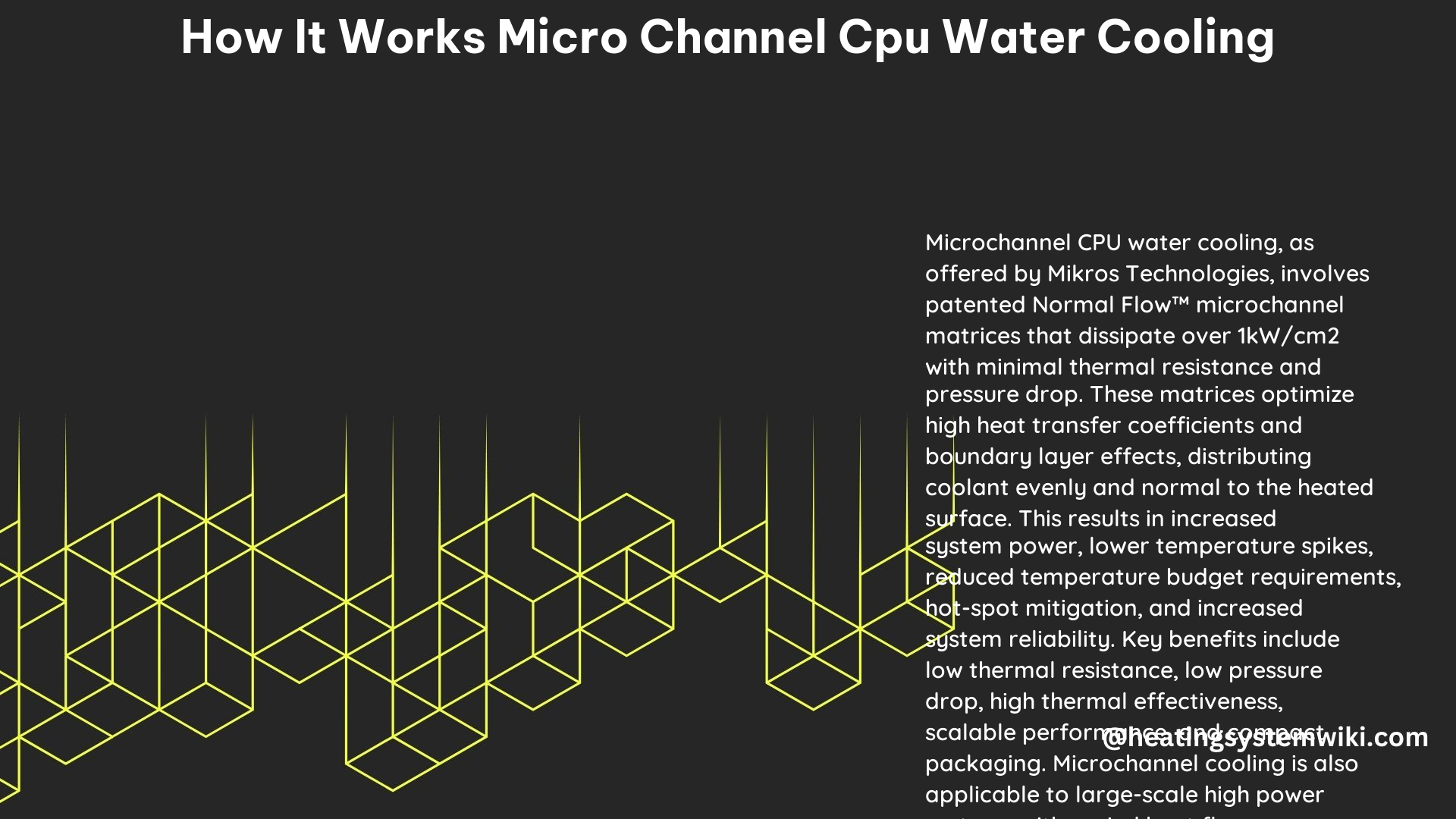Micro Channel CPU Water Cooling is a highly efficient cooling solution for high-performance computing systems. It works by circulating a liquid coolant through small channels, called microchannels, which are etched or manufactured into a cold plate that is in direct contact with the CPU. The microchannels have a high surface area-to-volume ratio, allowing for efficient heat transfer from the CPU to the coolant, which is then carried away to a radiator for dissipation.
Understanding Micro Channel Cooling Technology
Micro Channel Cooling Technology is a cutting-edge heat dissipation method that has revolutionized the way high-performance computing systems are cooled. The key components of this technology are:
-
Microchannels: These are tiny, narrow channels, typically ranging from 50 to 500 microns in width, that are etched or manufactured into a cold plate. The high surface area-to-volume ratio of these microchannels enables efficient heat transfer.
-
Cold Plate: The cold plate is a metal (usually copper) component that is in direct contact with the CPU. It is designed with the microchannel network to facilitate the flow of the liquid coolant.
-
Liquid Coolant: The liquid coolant, often water or a water-based solution, flows through the microchannels, absorbing heat from the CPU and carrying it away to a radiator for dissipation.
-
Radiator: The radiator is a heat exchanger that dissipates the heat from the liquid coolant into the surrounding environment, allowing the coolant to be recirculated through the system.
Advantages of Micro Channel Cooling

Micro Channel Cooling offers several advantages over traditional air-based cooling systems:
-
High Thermal Performance: The high surface area-to-volume ratio of the microchannels allows for efficient heat transfer, enabling the dissipation of high heat fluxes (over 1 kW/cm²) with low thermal resistance and pressure drop.
-
Compact Design: The small size of the microchannels allows for a more compact and space-efficient cooling solution, which is crucial in high-density computing environments.
-
Low Thermal Resistance: Micro Channel Cooling can achieve thermal resistances as low as 0.05°C/W, significantly outperforming traditional air-based cooling solutions.
-
Low Pressure Drop: The optimized channel design and flow characteristics of Micro Channel Cooling result in low pressure drops, typically around 3 psi, reducing the power required for the cooling system.
-
Improved Reliability: The efficient heat dissipation and low operating temperatures of Micro Channel Cooling can enhance the reliability and lifespan of high-performance computing components.
Micro Channel Cooling Manufacturers and Solutions
Several companies have developed advanced Micro Channel Cooling solutions for high-performance computing applications:
-
Mikros Technologies: Mikros Technologies offers patented Micro Channel Cooling solutions, such as their Normal Flow™ microchannel matrices, which can dissipate over 1 kW/cm² with a surface temperature rise of only 30°C and a pressure drop of 3 psi.
-
Cooler Master: Cooler Master, a leading manufacturer of PC cooling solutions, has developed Micro Channel Cooling water blocks for high-end CPUs, providing efficient heat dissipation and enabling high overclocking potential.
-
EKWB (EK Water Blocks): EKWB is a renowned manufacturer of custom liquid cooling solutions, including Micro Channel Cooling water blocks designed for optimal heat transfer and low pressure drop.
-
Corsair: Corsair, a prominent PC hardware and peripherals company, offers Micro Channel Cooling solutions in their high-performance liquid cooling systems, such as the Hydro Series.
-
Alphacool: Alphacool, a German manufacturer of liquid cooling components, has developed Micro Channel Cooling water blocks that feature intricate channel designs and micro-fins for enhanced heat dissipation.
Micro Channel Cooling Design Considerations
When designing a Micro Channel Cooling system, several key factors must be considered:
-
Channel Dimensions: The width, depth, and spacing of the microchannels can significantly impact the thermal performance and pressure drop of the system. Optimizing these parameters is crucial for achieving the desired cooling efficiency.
-
Coolant Flow: The flow rate, velocity, and turbulence of the coolant through the microchannels play a crucial role in heat transfer. Careful design and testing are required to ensure optimal coolant flow characteristics.
-
Material Selection: The choice of materials, such as copper or aluminum, for the cold plate and other components can affect the thermal conductivity, corrosion resistance, and overall system performance.
-
Manifold Design: The design of the inlet and outlet manifolds that distribute the coolant flow into and out of the microchannels can impact the pressure drop and flow distribution within the system.
-
Thermal Interface Materials: The use of high-performance thermal interface materials (TIMs), such as thermal greases or phase-change materials, between the CPU and the cold plate can enhance heat transfer and reduce thermal resistance.
-
Pump and Radiator Selection: The selection of the appropriate pump and radiator size and specifications is crucial for ensuring efficient heat dissipation and maintaining optimal system performance.
Conclusion
Micro Channel CPU Water Cooling is a highly advanced and efficient cooling solution that has revolutionized the way high-performance computing systems are cooled. By leveraging the high surface area-to-volume ratio of microchannels, this technology enables the dissipation of extremely high heat fluxes with low thermal resistance and pressure drop. Leading manufacturers, such as Mikros Technologies, Cooler Master, EKWB, Corsair, and Alphacool, have developed innovative Micro Channel Cooling solutions that cater to the demanding cooling requirements of modern high-performance computing systems.
References:
– Micro Channel Cooling Technology Overview
– Micro Channel Cooling Research at Penn State University
– Mikros Technologies Micro Channel Cooling Solutions
– How Liquid Cooling Works
– Micro Channel Cooling for High Heat Flux Applications
